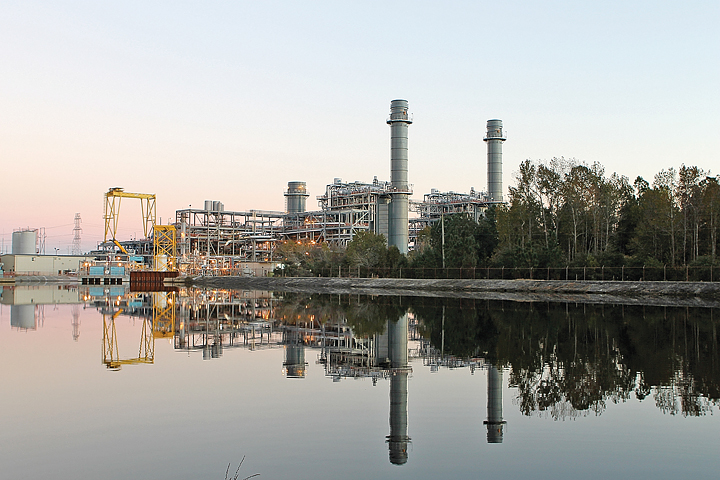Although it has been out of use since late 2013, the Sutton Steam Plant will soon be the center of activity as owner Duke Energy dismantles its landmark smokestacks and works to close the coal-ash ponds that are leaking pollutants into groundwater and the Cape Fear River.
Of the two, the coal-ash project will receive the greatest public scrutiny. Public pressure resulting from a massive spill in the Dan River near Eden last year prompted legislation ordering Duke to clean up all of its North Carolina coal-ash ponds by 2029. The Sutton lagoons were already known to be leaking, and the plant was among the four highest-priority sites. Its coal ash must be dug up and relocated by August 2019.
In March the utility fined the company $25.1 million as a result of the Sutton leaks. The company is appealing the action, which it calls unprecedented.
The first step in closing the ponds is dewatering, a process that will require dumping the water into the Cape Fear River. The permit limits the amount of heavy metals and other pollutants that can flow into the river.
The Sutton plant’s storage ponds contain 7.2 million tons of coal ash. When excavation begins — sometime within the next few weeks, once the final permit is issued — 2 million tons will be taken to an abandoned clay mine near Moncure in Chatham County. The rest will be stored in a new, heavily lined landfill on the Sutton site.
Several layers of synthetic and natural lining will surround the ash on both sites to prevent leakage, said Jeff Brooks, a spokesman for Duke Energy. In an email from the N.C. Department of Environment and Natural Resources, agency spokesman Mike Rusher said the company also will be required to monitor water quality and the integrity of the coal-ash storage facilities.
But Frank Holleman, senior attorney with the Southern Environmental Law Center in Chapel Hill, said the permit does not require daily testing for all pollutants and allows the utility to use an average of readings over a period of time. It seems like a small detail, he said, but what that means is the effluent could exceed pollution limits on any given day.
“Unfortunately, it is ineffective as written,” Holleman said.
On the plus side, he said, the permit now requires that Sutton Lake, a popular fishing spot on the Sutton property, be classified as a water of the state, as opposed to a discharge pond. That designation requires Duke to adhere to water quality standards.
The reclassification requires modification of the site’s National Pollutant Discharge Elimination System (NPDES) permit. In an email explaining some of the permit’s provisions, N.C. Department of Environment and Natural Resources spokesman Mike Rusher said the lake will be monitored to ensure safe fishing. A study by a Wake Forest biologist and promoted by the environmental law center found high levels of selenium, thallium, arsenic and other toxic elements in Sutton Lake, as well as fish with severe deformities.
Brooks wouldn’t specifically say whether the significant cost of closing the ash ponds will be passed on to customers. But, he said, “We do see basin closure as part of the normal life cycle of the plant.” The state utilities commission allows those costs to be included in rate-setting decisions, he said.
Environmental and consumer groups have suggested that Duke and its shareholders should bear the entire cost because the work is a result of pollution caused by the coal-ash lagoons.
A public hearing on the discharge permit will be held at 6 p.m. Aug. 5 at Cape Fear Community College’s Union Station Auditorium, 502 N. Front St., Wilmington. People wishing to speak may sign up beginning at 5 p.m.
Comments also will be accepted by email at –[email protected], and by mail at Wastewater Permitting, 1617 Mail Service Center, Raleigh, N.C., 27699-1617. All comments must be received by Aug. 5.
To view a copy of the permit online, visit the following link: http://bit.ly/1MD9Ezg
In addition to the ash excavation, separate crews will be dismantling the 550-foot, red-and-white ringed smokestacks a few feet at a time, Brooks said. The stacks at the former coal-fired plant off U.S. 421 north of Wilmington are a familiar part of the local skyline, but they will soon be no more.
A ring-shaped machine will be used to deconstruct the stack at a rate of about 10 feet per week, Brooks said. The work could begin within a few weeks, he said.
The stacks were attached to the steam plant, which was replaced in 2013 by one fueled by cleaner-burning natural gas.
email [email protected]




